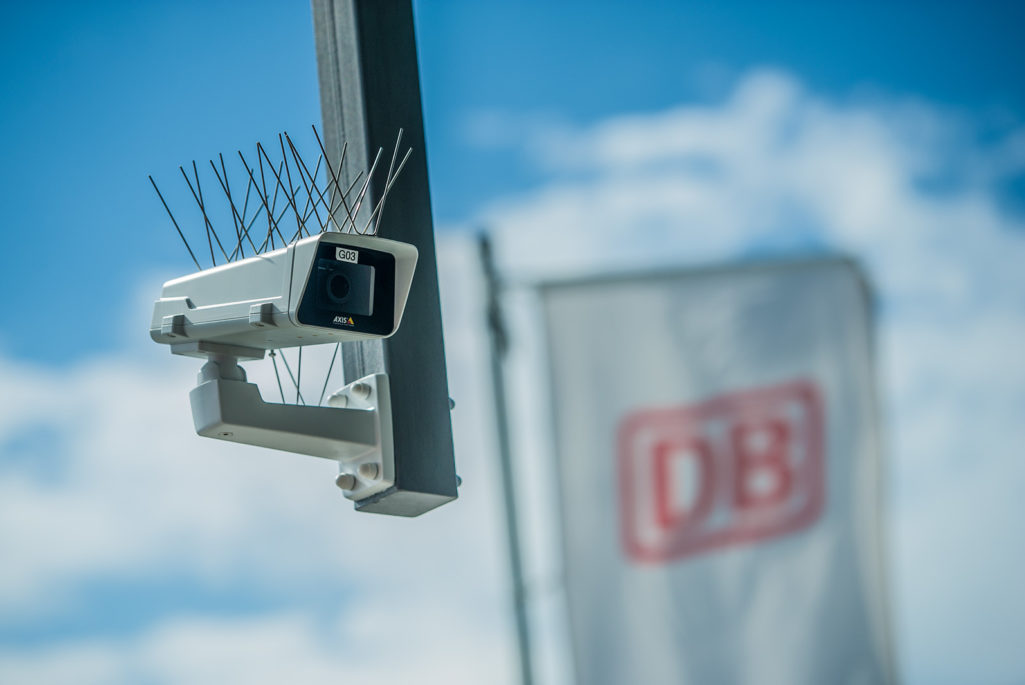Disruptive Technology Brings Risk and Opportunity to Infrastructure Projects

Signs of the new social infrastructure: A surveillance camera that is part of a facial recognition technology test at Berlin Suedkreuz station in Berlin, Germany. The technology is touted as being able to track terror suspects and help prevent future attacks.
Photo: Steffi Loos/Getty Images
The infrastructure industry has not typically been known for its embrace of new technology. In a recent paper, the World Economic Forum (WEF) attributed the industry’s relatively slow adoption of technological innovation to a number of internal and external challenges in the engineering and construction sector: “The persistent fragmentation of the industry, inadequate collaboration with suppliers and contractors, the difficulties in recruiting a talented workforce, and insufficient knowledge transfer from project to project.”
Change is inevitable and innovation is disrupting the way we design, build, operate and use infrastructure. Whether it’s in civil infrastructure—roads, bridges, pipelines, and ports—industrial infrastructure, or social infrastructure, technological advancements are creating efficiencies in the way we operate. While technology adoption can help to promote sustainable growth, there are also risks to be managed.
Innovation Transforms Infrastructure Design
Innovation dictates that infrastructure needs to be conceptualized and designed differently.
Consider something as basic to society as roads, and add to that the coming of autonomous vehicles—both for passengers and in trucking. Because autonomous vehicles rely to a large degree on sensing technology, we need to consider if roads, bridges, tunnels, and other infrastructure are being designed adequately for this new means of transportation. Beyond efficiency gained from proper design, what are the potential liability implications for inadequate design?
Big data and analytics have also infiltrated how we design infrastructure. For example, building information modeling (BIM) is realizing broader applicability as its technology develops. Historically used for 3-D modeling in the design phase, continuing innovations in BIM will enable faster and better infrastructure development, as well as provide insights into how a project will perform throughout its life cycle, allowing a view into a project’s future risk profile. This innovation in BIM promotes efficiency by allowing those who design infrastructure to provide real-time support to those building it.
Building Sites Benefit from New Technologies
Construction sites are incubating grounds for a range of technology innovations in such areas as wearables and telematics.
Wearable technologies, for example, are rapidly changing the work landscape and promoting safety, accuracy and efficiency. Among the advancements in construction technologies is the smart hard hat, which allows technicians to project 3-D images in the natural environment, such as a bridge span, through augmented reality (AR)—the same technology behind Pokémon Go.
Enhanced safety vests borrow concepts from vehicle telematics. These vests are equipped with GPS and radio-communicating technology to enhance workforce safety and prevent injuries by warning users as they enter hazard zones. It’s not hard to imagine a future in which workers wear an exoskeleton that will improve safety, enhance efficiency, and allow for the instantaneous exchange of data.
Technology will also enable infrastructure to be built by fewer humans—potentially enhancing safety and promoting resource efficiency. Balfour Beatty, a large international construction firm, suggests that by 2050 some infrastructure will be built without physical human labor. It is not difficult to anticipate that in our lifetime infrastructure will be designed and constructed using 3-D printing and installed by robots and mechanistic devices that operate with artificial intelligence.
Change is inevitable and innovation is disrupting the way we design, build, operate and use infrastructure.
Operation and Utilization of Infrastructure will Change
Once these innovative infrastructure assets become operational, they will likely include embedded technologies, such as the intelligent transportation systems (ITS) used on many highways and freeways. These incorporate a variety of technologies including Bluetooth, video, and other wireless systems to promote efficient traffic management, allow for toll tracking and billing, enhance emergency response times, and assist law enforcement. With the coming of autonomous vehicles, it’s likely that additional sensing technology will be needed to improve safety.
Beyond impacting how society uses and engages with roads and other infrastructure, interconnectivity will allow individual components to interact on an almost “live” basis. For example, it’s anticipated that, in the near future, individual infrastructure components will contain monitoring technology that will provide real-time information about their operating efficiency and life span. When such components need replacement, the sensors will put in the order.
There is no question that innovation in robotics, automation, and other technology will continue to alter the way infrastructure evolves and the way we use it. These technologies promote efficiency, connectivity and sustainable growth.
Infrastructure Risks also Shift
With innovation comes risk, however, as technological disruption also increases volatility and exacerbates emerging issues, including those related to social stability as well financial viability and cybersecurity.
Social disruption: If innovation does eventually displace large numbers of construction crews, drivers, or other workers, it’s possible there could be considerable social unrest in some parts of the world. According to executives participating in a recent World Economic Forum event, it will be critical for industry to plan ahead by investing in education and training for workers whose jobs could be made redundant due to technological advancement.
Financial viability: As technology advances, will the infrastructure we design and build today be useful in 20 to 30 years? How quickly will it become obsolete? What if we have flying cars? That may sound harebrained at face value, but compare the world we live in today to what people thought was possible just 20 or 30 years ago. Once we integrate technology into physical infrastructure, it can quickly become outdated.
This is particularly important in the context of privately financed infrastructure, where the private sector takes on the life-cycle management of infrastructure. Obsolescence is of particularly heightened risk to private concession companies who have assumed revenue risk (e.g. tolling) based on financial models that were unable to incorporate disruption in infrastructure utilization. The firms exposed to the financial risk related to infrastructure obsolescence could be builders, engineering firms, and/or equity firms and financiers developing and maintaining infrastructure.
Cybersecurity: Because infrastructure now needs to be able to integrate with and connect to technology, such as smart buildings, autonomous vehicles, and transit systems, cybersecurity risks become more of a threat than in the past. The interconnectedness of our infrastructure through the Internet of Things (IoT) will face cybersecurity risks. Infrastructure may increasingly become a target for sophisticated organized crime looking to extract sensitive information. Firms with proprietary software, systems and infrastructure may become targets of corporate and political espionage.
Hackers have long probed for weaknesses in critical infrastructure. The ability for cyber events to affect infrastructure has grown, as seen in two recent global attacks involving malware—WannaCry and Petya. Infrastructure from hospitals to marine ports suffered financial losses and damage due to those events.
Perhaps the most frightening risk from an infrastructure perspective is that of cyberterrorists seeking to invoke fear. In the age of digitization and IoT, there are legitimate concerns that cyberterrorists could gain access to flood control gates, traffic lighting systems, public transit systems, or even the doomsday scenario of shutting the electric grid down completely. Cybersecurity continues to be one of the global risks of highest concern.
Today’s new technologies almost always increase connectivity, including in the ways we build, operate, and maintain infrastructure. Companies involved in infrastructure can no longer afford to think of cyber risk as an afterthought, but need to adopt strong cyber-risk management practices from day one.
Thankfully there is a bustling market emerging in the risk management and insurance industry to address cybersecurity. In addition to consulting services developed to assess and manage cybersecurity exposures, insurers have developed products to transfer the risks that infrastructure stakeholders face as well as support risk mitigation by establishing incident response plans. These products, which are triggered by cybersecurity breaches whether motivated by financial crime or terrorism, can cover expenses related to extortion, property damage or financial loss related to a data and privacy breach or network outage.
One recent estimate from the Global Infrastructure Hub, a G20 initiative, says there is a need for $94 trillion in infrastructure investments by the year 2040.
At the same time, it’s clear that rapid technological advancement is changing the way we design, build, operate, and use infrastructure. Innovation in infrastructure will enable growth and promote economic, environmental and social vitality.
But advancement comes with risks—including social disruption, obsolescence and cybersecurity threats. These risks can be mitigated by forward-thinking city planning, investment, and integration of education into our workplace as well as an increase in cyber-oriented defenses.




